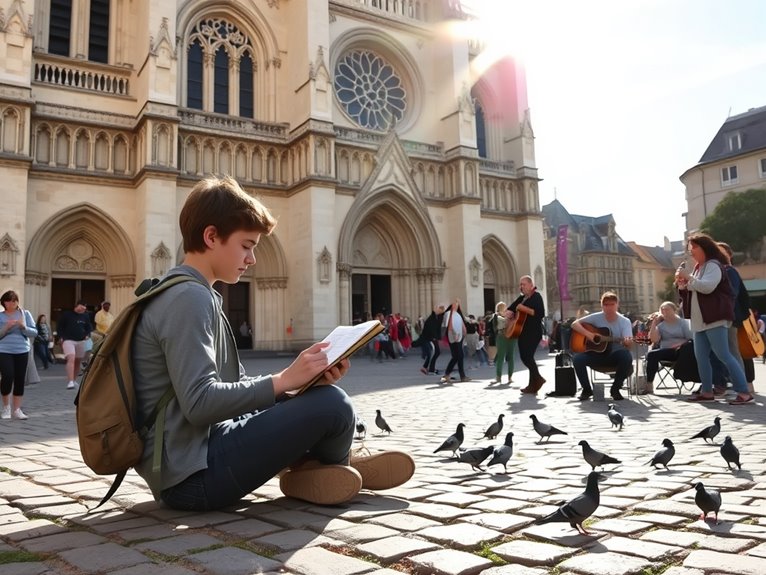
10 Free Things to Do in Paris for Budget Travelers
I've discovered some amazing free activities in Paris that'll help you explore the city on a budget! Start at the Luxembourg Gardens' peaceful paths, then climb to Montmartre's artistic streets and Sacré-Cœur's stunning views. Don't miss walking along the Seine's banks, visiting Notre-Dame's exterior, or exploring Père Lachaise Cemetery. You can also enjoy free museum Sundays, Canal Saint-Martin's atmosphere, and open-air markets. Let me share more insider tips to make your Paris adventure unforgettable!
Stroll Through the Luxembourg Gardens
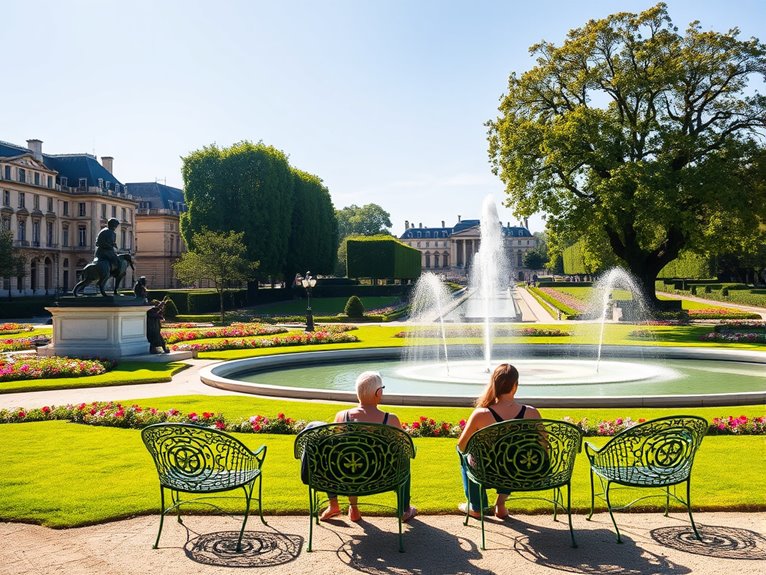
The Luxembourg Gardens (Jardin du Luxembourg) stands as one of Paris's most beloved green spaces, offering visitors a perfect blend of French formal gardens and English landscape design. This 23-hectare oasis in the heart of the Latin Quarter has been enchanting visitors since its creation in 1612 by Marie de' Medici, who wanted to recreate the Boboli Gardens from her native Florence.
Walking through these magnificent gardens provides a genuine slice of Parisian life, where locals and tourists alike gather to relax, play chess, watch children sail toy boats, or simply admire the stunning array of flowers and sculptures. The gardens surround the grand Luxembourg Palace, now home to the French Senate, creating a majestic backdrop for one of Paris's most democratic spaces.
Quick Facts:
- Opening Hours: 7:30 AM to sunset (varies seasonally)
- Best Times to Visit: Early morning or late afternoon
- Photography Allowed: Yes, except for commercial purposes
- Seating: Free chairs throughout the garden
- Facilities: Public restrooms, water fountains
- Accessibility: Wheelchair accessible paths
- Peak Season: April to October
- Best Photo Spots: Central fountain, palace façade, main flowerbeds
The Central Area
The heart of the gardens features the grand octagonal basin where children sail miniature boats, available for rent from nearby vendors. The surrounding area showcases perfectly manicured lawns, vibrant flower beds, and over 100 statues, including the iconic Medici Fountain. This central section offers the best photo opportunities, particularly during golden hour when the light perfectly illuminates the palace.
The Western Section
This quieter area houses the famous apple orchards, beehives, and the oldest tree in Paris, planted in 1814. The less-visited western paths provide peaceful spots for reading or contemplation, with fewer tourists and more locals. An insider tip: visit the small garden house near the beehives where free honey-tasting sessions occasionally occur.
The Eastern Section
Home to the historic puppet theater (Théâtre du Luxembourg) and a charming carousel, this section is perfect for families. The enclosed playground requires a small fee, but the surrounding areas offer free entertainment, including occasional music performances in the bandstand during summer months.
Pro Tips:
For the most serene experience, visit early morning when local joggers and early risers create an authentic Parisian atmosphere. The gardens are less crowded on weekdays, and the best photos can be captured during the first hour after opening when the morning light creates a magical glow across the fountains and palace façade. Bring a book or picnic to fully embrace the local tradition of lingering in these historic grounds.
Practical Advice:
The metal chairs scattered throughout the gardens are free to use, but avoid sitting on the grass as it's generally prohibited. Enter through the less busy Rue Guynemer entrance to avoid the main gate crowds, and keep your belongings close as the gardens can get busy during peak times. During summer, arrive early to secure a chair near the central fountain, as these prime spots fill quickly with sun-seeking Parisians.
Visit the Notre-Dame Cathedral Exterior

Standing majestically on the Île de la Cité, Notre-Dame Cathedral remains one of Paris's most iconic landmarks, even as it undergoes restoration following the devastating 2019 fire. While the interior remains closed for reconstruction, the cathedral's exterior continues to captivate millions of visitors with its stunning Gothic architecture, legendary gargoyles, and historical significance dating back to the 12th century.
The cathedral's exterior viewing area offers visitors a unique opportunity to witness both architectural history and modern restoration in action. From the square of Jean-XXIII and the Seine River banks, tourists can admire the flying buttresses, ornate sculptures, and the gradual rebirth of this UNESCO World Heritage site without spending a single euro.
Quick Facts:
- Best viewing times: Early morning (8-10 AM) or evening (7-9 PM) for ideal lighting
- Photography permitted: Yes, without restrictions
- Viewing distance: Minimum 10 meters from construction barriers
- Best photo spots: Square Jean-XXIII (behind cathedral), Pont de l'Archevêché
- Accessibility: Wheelchair accessible viewing areas available
- Nearby metro stations: Cité (Line 4), Saint-Michel (Line 4, RER B, C)
Primary Viewing Areas:
The Parvis Notre-Dame offers the most impressive frontal view of the cathedral's western facade. This large square provides an excellent vantage point to observe the intricate details of the main entrance portals and the remaining bell towers. The square often hosts informative panels explaining the cathedral's history and ongoing restoration efforts.
Left Bank Views:
Cross to the Left Bank of the Seine for stunning perspectives of the cathedral's southern facade and flying buttresses. The small park at Square Jean-XXIII provides peaceful benches and green spaces perfect for sketching or photography. An insider tip: this location offers the best angles for capturing the cathedral's architectural details without construction equipment in frame.
Seine River Vantage Points:
The bridges near Notre-Dame – particularly Pont de l'Archevêché and Pont au Double – offer unique views of the cathedral's eastern end and flying buttresses. Lesser-known fact: the early morning light creates a golden glow on the cathedral's limestone facade, making it an ideal time for photographers.
Pro Tips:
Visit during "golden hour" (one hour before sunset) when the declining sun bathes the cathedral's facade in warm light, creating dramatic shadows and highlighting architectural details. For the clearest views with minimal crowds, arrive before 9 AM, especially during peak tourist season (June-August). Consider bringing binoculars to observe the detailed sculptural elements and gargoyles from a distance.
Practical Advice:
While viewing the exterior is free, the area can become extremely crowded, particularly between 11 AM and 4 PM. Consider combining your visit with other nearby attractions like the Archaeological Crypt (paid entry) or a stroll through the charming Île Saint-Louis. Remember that construction work is ongoing, so some views may be partially obstructed by scaffolding, which typically moves to different sections of the cathedral throughout the restoration process, scheduled to complete in 2024.
Explore the Charming Montmartre District

Perched atop the highest hill in Paris, Montmartre stands as a symbol of the city's artistic soul, where cobblestone streets wind through a neighborhood that once housed legendary artists like Picasso, Van Gogh, and Renoir. This historic district, crowned by the gleaming white Sacré-Cœur Basilica, maintains its village-like atmosphere despite being one of Paris's most visited areas.
Walking through Montmartre feels like stepping into a living painting, where every corner reveals another Instagram-worthy scene. From the bustling Place du Tertre filled with working artists to hidden vine-covered houses and centuries-old windmills, this free walking adventure offers an authentic glimpse into both historic and modern Parisian life.
Quick Facts:
- Best visiting hours: Early morning (before 10 AM) or evening (after 6 PM)
- Photography prime time: Sunset from Sacré-Cœur steps
- Walking difficulty: Moderate (steep hills and stairs)
- Metro stations: Abbesses (Line 12), Anvers (Line 2)
- Best days: Tuesday-Thursday (fewer crowds)
- Duration: 2-3 hours for a complete exploration
Notable Free Attractions:
Sacré-Cœur Basilica
This Roman-Byzantine church offers free entry and Paris's most spectacular city views. Open daily from 6:30 AM to 10:30 PM, the basilica's exterior steps serve as Paris's most popular sunset-watching spot. Insider tip: Access the lesser-known back entrance via Square Marcel Bleustein-Blanchet for shorter queues.
Place du Tertre
The heart of Montmartre's artistic scene, this square hosts dozens of artists painting portraits and selling artwork. While portrait sessions cost money, watching artists work is free. Visit early morning to see artists setting up their easels and enjoy the square without crowds.
La Maison Rose
This iconic pink house with green shutters, immortalized by numerous artists, stands at the corner of Rue de l'Abreuvoir. While dining here isn't free, photographing this famous landmark costs nothing. Secret tip: The best photo angle is from the slight incline of Rue de l'Abreuvoir, looking up.
Vineyard of Montmartre (Clos Montmartre)
Paris's last working vineyard offers a unique glimpse into the area's agricultural past. While entering the vineyard requires a guided tour, viewing it from the surrounding streets is free. Visit in October during the annual grape harvest festival for special free events.
Pro Tips:
Navigate Montmartre like a local by avoiding the main tourist thoroughfares. Instead, explore the network of quiet back streets like Rue Saint-Vincent and Rue des Saules, particularly during mid-day when tour groups flood the main attractions. For photographers, the magical "blue hour" just after sunset creates perfect lighting conditions for capturing the neighborhood's romantic atmosphere.
Practical Advice:
Wear comfortable, non-slip walking shoes as Montmartre's hills feature many steep sections and slippery cobblestones. Carry a water bottle and small snacks, as prices in tourist areas can be inflated. Consider downloading an offline map, as the winding streets can be confusing, and remember that most authentic local shops and cafes close on Mondays.
Discover the Père Lachaise Cemetery
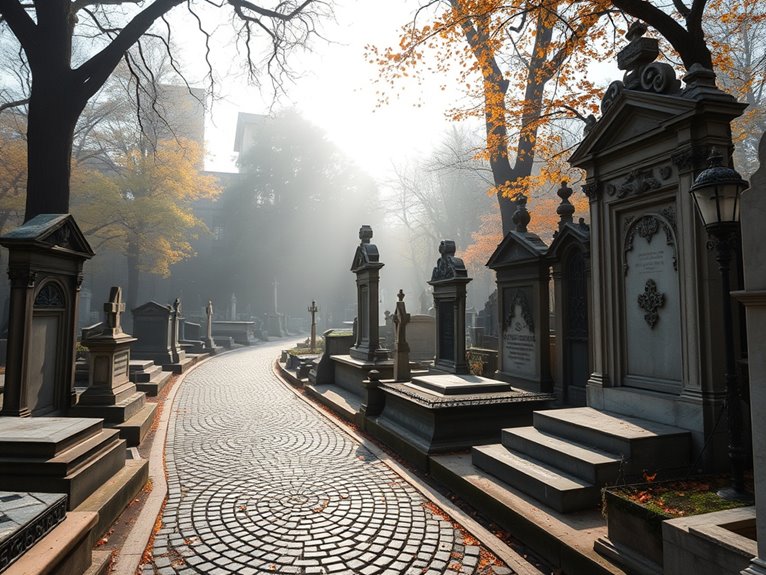
Sprawling across 110 acres in Paris's 20th arrondissement, Père Lachaise Cemetery stands as the world's most visited necropolis and a tribute to centuries of artistic, cultural, and historical legacy. This hauntingly beautiful cemetery, established in 1804 by Napoleon Bonaparte, serves as the final resting place for countless luminaries, from Jim Morrison to Oscar Wilde, making it an unexpected yet intriguing destination for cultural exploration.
Beyond its role as a cemetery, Père Lachaise functions as an open-air museum, featuring stunning funerary art, Gothic tombs, and architectural masterpieces that span various periods and styles. The cemetery's cobblestone paths wind through an urban forest, creating a peaceful sanctuary where visitors can contemplate history while discovering the stories behind some of the world's most influential figures in arts, literature, and politics.
Quick Facts:
- Opening Hours: March to November 8:00 AM – 6:00 PM; November to March 8:00 AM – 5:30 PM
- Cost: Free admission
- Best Time to Visit: Early morning or late afternoon for ideal lighting and fewer crowds
- Photography: Allowed, but be respectful of mourners and ongoing ceremonies
- Guided Tours: Available in multiple languages (paid service)
- Accessibility: Hilly terrain with some steep paths; comfortable walking shoes recommended
- Nearest Metro: Père Lachaise (Line 2 and 3), Philippe Auguste (Line 2)
The cemetery's most famous residents have become cultural touchstones, drawing visitors from around the globe. Jim Morrison's grave, marked by constant crowds and offerings from fans, lies in a quiet corner of the cemetery. Oscar Wilde's tomb, adorned with a distinctive Art Deco angel, bears countless lipstick kisses from admirers, though a glass barrier now protects the stone. Other notable graves include Édith Piaf, Chopin, and Marcel Proust, each telling its own story through unique memorial designs and personal tributes.
Pro Tips:
The cemetery's vastness can be overwhelming, but downloading the free official map or using the interactive kiosks at the entrances helps navigate effectively. Visit during shoulder seasons (spring or fall) when the changing foliage adds atmospheric beauty and crowds are thinner. Photography enthusiasts should arrive during the "golden hour" before sunset when the light filtering through the trees creates ethereal effects on the monuments.
Practical Advice:
While the cemetery is free to explore, investing in a guided tour or detailed guidebook greatly enhances the experience by revealing the stories and symbolism behind the monuments. Enter through the main entrance on Boulevard de Ménilmontant for easier orientation, and allow at least three hours for a meaningful visit. Bring water and snacks as there are no vendors inside, and remember to dress respectfully as this remains an active cemetery where funeral services take place daily.
Walk Along the Seine River Banks
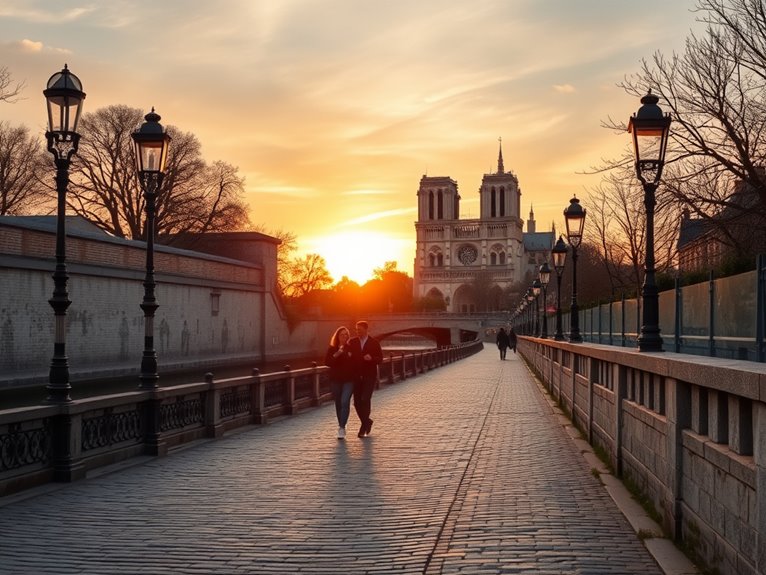
The Seine River is the beating heart of Paris, flowing through the city's historic center and offering one of the most enchanting free experiences in the French capital. This UNESCO World Heritage site provides an intimate glimpse into Parisian life, where centuries of history unfold along its embankments, bridges, and quays.
Following the Seine's gentle curves reveals a tapestry of Parisian culture, from street musicians and artists to couples strolling hand in hand, and bouquinistes selling vintage books from their iconic green metal boxes. The riverside walk connects many of Paris's major landmarks, including Notre-Dame Cathedral, the Louvre, and the Eiffel Tower, making it an essential activity for budget-conscious travelers.
Quick Facts:
- Best times: Early morning (6-8 AM) or sunset (7-9 PM)
- Length: 13 km through central Paris
- Accessibility: Mostly flat, wheelchair accessible
- Safety: Well-lit and patrolled at night
- Photography: Golden hour lighting best for iconic shots
- Seasonal highlights: Spring blooms, summer entertainment, autumn colors
Left Bank (Rive Gauche)
The Left Bank represents Paris's artistic soul, stretching from the Latin Quarter to the Eiffel Tower. This section features the famous Shakespeare and Company bookstore, numerous café terraces, and the Institut de France. Visit the Square du Vert-Galant, a peaceful park at the western tip of Île de la Cité, for a perfect picnic spot most tourists overlook.
Right Bank (Rive Droite)
The Right Bank showcases a more grandiose Paris, with the Louvre's façade and the City Hall (Hôtel de Ville) reflecting in the river's waters. The recently pedestrianized Berges de Seine offers wooden loungers, floating gardens, and recreational areas. Lesser-known highlight: check out the Pont des Arts early morning for stunning sunrise photos without the usual crowds.
Bridges (Ponts)
Paris's 37 bridges across the Seine each tell their own story. The Pont Alexandre III, with its ornate lamp posts and golden statues, is the most decorative. The Pont Neuf, ironically Paris's oldest bridge, offers excellent views of both banks. Insider tip: Visit Pont de Bir-Hakeim at night for a unique view of the Eiffel Tower's light show reflected in the river.
Pro Tips:
The best walking experience comes from combining upper and lower levels of the riverbank. Start at river level (quais) for intimate water views, then climb to street level at strategic points for spectacular vistas. During summer months, temporary beaches (Paris Plages) transform the riverbanks into urban seasides complete with sand, palm trees, and free activities.
Practical Advice:
Wear comfortable walking shoes and bring a water bottle, as fountains along the route are limited. Download the Paris Walking Tours app for self-guided historic information, and carry a light jacket even in summer, as the river creates its own microclimate. Most importantly, time your walk to include both daylight and evening hours to experience the dramatic transformation of the riverbanks when the city lights come alive.
Admire Street Art in the Marais
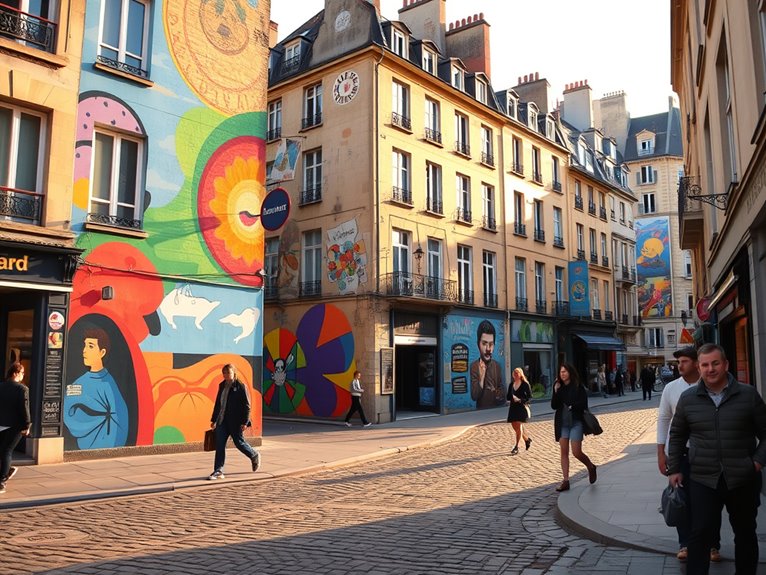
The historic Marais district of Paris has transformed into one of the city's most vibrant open-air galleries, where centuries-old architecture serves as a canvas for contemporary street artists. From elaborate murals spanning entire buildings to subtle stencil works tucked away in narrow passages, the neighborhood offers an ever-changing exhibition of urban creativity that costs nothing to explore.
Walking through the Marais's medieval streets reveals a fascinating contrast between traditional French architecture and modern street expression. International artists like Invader, Seth, and local creators have left their mark throughout the quarter, turning this fashionable neighborhood into a reflection of Paris's thriving street art scene.
Quick Facts:
- Best viewing times: 10am-4pm for ideal lighting
- Photography allowed: Yes, without restrictions
- Walking distance: 2-3 kilometers for main areas
- Seasonal consideration: Year-round activity, but avoid rainy days
- Accessibility: Mostly flat terrain, some cobblestone streets
- Tour duration: 1-2 hours for self-guided exploration
Notable Street Art Locations:
Rue Denoyez
This street serves as the epicenter of Marais street art, with constantly changing murals and pieces. Located near the Belleville metro station, the entire street is legally dedicated to street art, allowing artists to create freely. The walls change weekly, making each visit unique.
Space Invader Mosaics
Throughout the Marais, spot the iconic pixel-art mosaics by anonymous artist Invader. These small installations typically appear at street corners and above doorways. The best-preserved piece resides at the corner of Rue des Archives and Rue des Blancs Manteaux.
Le M.U.R. (The Wall)
Located at the intersection of Rue Oberkampf and Rue Saint-Maur, this designated art space features curated works that change every two weeks. The association managing the wall invites different artists to create temporary installations, ensuring fresh content year-round.
Pro Tips:
Morning light offers the best photography conditions, while fewer pedestrians block the views. Consider downloading a street art map application like "Street Art Paris" to locate specific pieces. Many works are temporary, so photograph interesting pieces when you see them – they might be gone on your next visit.
Practical Advice:
Bring comfortable walking shoes and a camera with good low-light capabilities for shooting in narrow streets. Start at Place de la République and work your way through the smaller streets rather than main thoroughfares for the best discoveries. Consider joining one of the free walking tours that focus on street art, typically departing from the Pompidou Center on weekend mornings, though advance booking is recommended.
Visit Free Museums on First Sundays
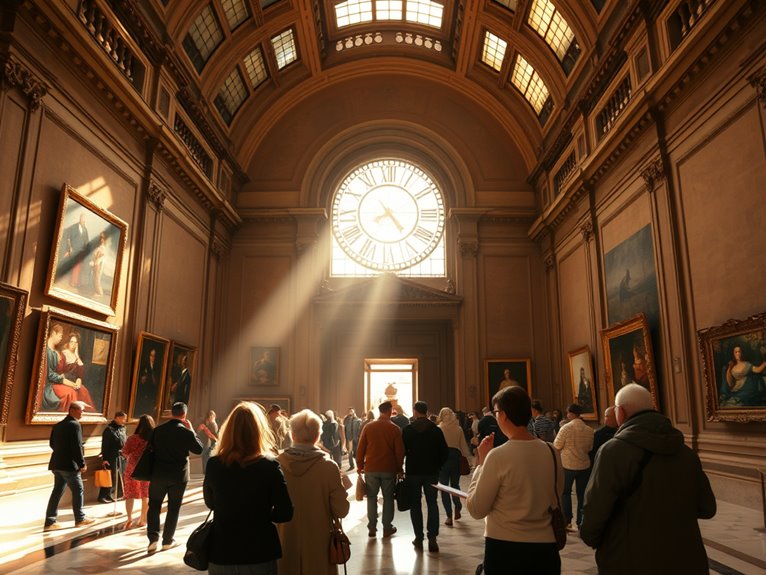
Paris's world-renowned museums house some of humanity's greatest artistic and cultural treasures, but regular admission fees can quickly drain a traveler's budget. Fortunately, many of the city's premier museums offer completely free admission on the first Sunday of each month, making art and culture accessible to everyone.
This cherished Parisian tradition allows visitors to explore prestigious institutions like the Louvre, Musée d'Orsay, and Centre Pompidou without spending a euro. While these free days tend to draw larger crowds, strategic planning can help you maximize this opportunity to experience Paris's cultural richness while keeping your wallet intact.
Quick Facts:
- Available: First Sunday of every month, year-round
- Operating Hours: Typically 9:00 AM – 6:00 PM
- Wait Times: 30-90 minutes during peak hours
- Photography: Usually allowed without flash
- Advance Booking: Not required/not available on free days
- Best Arrival Time: 8:30 AM or after 3:00 PM
- Seasonal Considerations: Summer months see highest attendance
Participating Museums and Details:
The Louvre
The world's largest art museum offers its entire collection free of charge. View the Mona Lisa, Venus de Milo, and countless other masterpieces without paying the usual €17 entry fee. Located in the 1st arrondissement, the museum opens at 9:00 AM. Insider tip: Enter through the Porte des Lions entrance instead of the main pyramid to encounter shorter lines.
Musée d'Orsay
Housed in a beautiful former railway station, this museum showcases impressive Impressionist works. Visit from 9:30 AM to 6:00 PM to see works by Van Gogh, Monet, and Renoir. Insider tip: Head to the fifth floor first for the best viewing experience and shorter queues for famous pieces.
Centre Pompidou
This modern and contemporary art museum offers free entry from 11:00 AM to 9:00 PM. The unique inside-out architecture makes it unmistakable in the Marais district. Insider tip: The outdoor escalators offer fantastic city views – take them even if you're heading to a lower floor.
Pro Tips:
Plan to visit your top-priority museum first thing in the morning, as crowds build throughout the day. Consider splitting your museum visits between morning and late afternoon, using the middle of the day to explore nearby neighborhoods or have lunch. Download museum maps in advance to plan your route to must-see works efficiently.
Practical Advice:
Free Sundays don't include special exhibitions, so check museum websites for current offerings. Bring water and snacks as museum cafes tend to be crowded on free days. Consider visiting smaller museums that are typically free year-round on busy first Sundays when major museums are most crowded. Remember that security checks are still in place, so avoid bringing large bags or suitcases to speed up entry.
Relax at Canal Saint-Martin
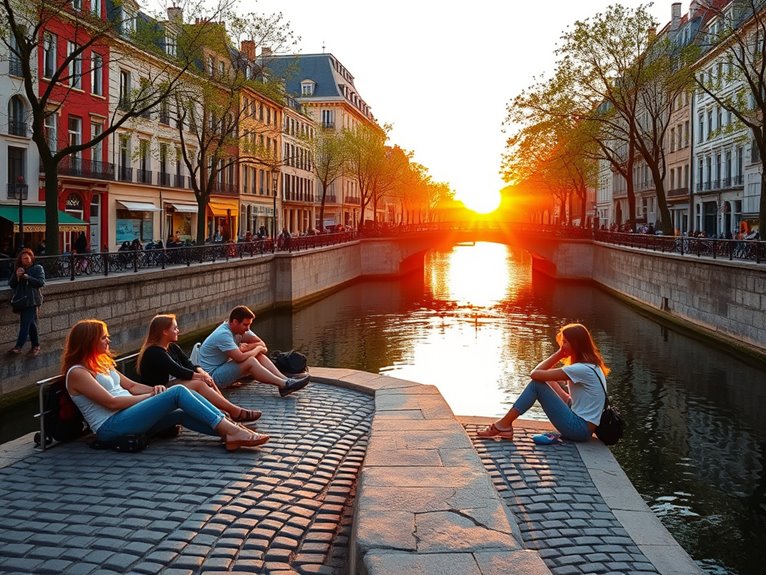
The Canal Saint-Martin stands as one of Paris's most charming waterways, offering budget travelers a picturesque setting without spending a single euro. This 4.5-kilometer canal, built in 1825 under Napoleon Bonaparte, has transformed from a functional waterway into a beloved social hub where locals and tourists alike gather for peaceful moments along its tree-lined banks.
Once a working-class neighborhood, the area surrounding Canal Saint-Martin has evolved into a trendy district while maintaining its authentic Parisian charm. Iron footbridges arch gracefully over the water, while the stone quays provide perfect perches for picnicking, people-watching, or simply soaking in the atmosphere of real Parisian life away from major tourist attractions.
Quick Facts:
- Best visiting hours: 10 AM – sunset (most lively from 4 PM – 8 PM)
- Most popular days: Weekends and summer evenings
- Photography lighting: Best during golden hour (just before sunset)
- Nearest Metro stations: République, Goncourt, or Jacques Bonsergent
- Picnic-friendly zones: Entire length of the canal
- Safety: Well-lit and populated until late evening
- Best seasons: Spring through fall
The main stretch of the canal between République and Stalingrad offers the most atmospheric experience. The water is punctuated by a series of locks and romantic bridges, with the most photographed spot being the double lock near Rue de la Grange aux Belles. Street artists frequently perform here, and the surrounding area features numerous affordable cafes and bakeries perfect for gathering picnic supplies.
Several iconic spots along the canal deserve special attention. The Pont de la Grange-aux-Belles provides excellent views of boats maneuvering through the locks, while the corner of Rue de Lancry offers a quintessential canal photo opportunity. Hidden gem: Look for the water marks on the lock walls showing historical flood levels, offering a fascinating glimpse into the canal's history.
Pro Tips:
Visit during summer evenings when locals gather for "apéro" (pre-dinner drinks and snacks) along the canal banks. The atmosphere becomes especially magical as the sun sets and street lamps illuminate the water. For the best experience, arrive around 6 PM with a blanket, some cheese, bread, and wine from nearby shops – just like a local Parisian.
Practical Advice:
While the canal area is generally safe, keep valuables secure and be aware of your surroundings, especially after dark. Bring a water bottle and some snacks, as prices at canalside establishments can be higher than in surrounding neighborhoods. Consider combining your canal visit with exploration of the trendy boutiques and vintage shops in the adjacent 10th arrondissement for a full day of free entertainment.
Experience the Sacré-Cœur Basilica Views
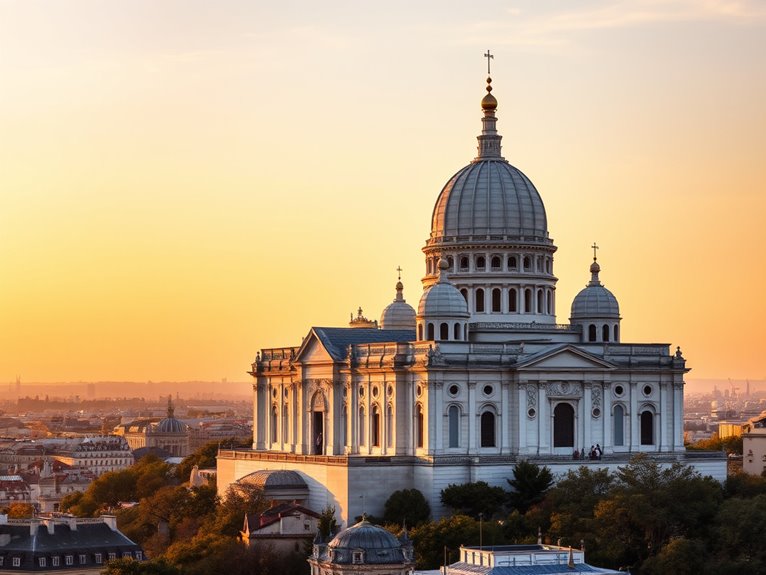
Perched atop Montmartre, the highest hill in Paris, the Sacré-Cœur Basilica offers one of the most breathtaking free panoramic views of the City of Light. This Romano-Byzantine basilica, with its distinctive white travertine stone exterior, stands as both a religious monument and an unparalleled observation point, drawing visitors from around the world to its steps and dome.
The sweeping 360-degree vista encompasses nearly every major landmark in Paris, from the Eiffel Tower to Notre-Dame, stretching across the city's romantic rooftops and chimneys. While the basilica itself is a masterpiece of architecture, the real treasure lies in the unobstructed views available from its elevated position, making it an essential stop for photographers, romantics, and anyone seeking to understand Paris's layout and scale.
Quick Facts:
- Best visiting hours: Sunrise to sunset (basilica open 6:30 AM – 10:30 PM)
- Photography allowed: Yes (restricted inside the basilica)
- Best viewpoint: Steps and parvis (church square)
- Accessibility: 237 steps or funicular (funicular requires metro ticket)
- Crowd levels: High midday, lower early morning and evening
- Security: Be aware of pickpockets, especially on crowded steps
The Exterior View Experience
The grand steps leading to the basilica provide the most popular viewing spot, with plenty of space to sit and take in the panorama. The steps are arranged in several levels, creating natural viewing terraces. From this vantage point, visitors can spot major landmarks while enjoying street performers and the lively atmosphere of Montmartre. Insider tip: The less-known side steps on either side of the main staircase offer equally stunning views with fewer crowds.
The Dome Perspective
For those willing to pay a small fee (€6), access to the dome provides an even higher viewing point. Climbing 300 additional steps rewards visitors with an intimate look at the basilica's architecture and an even more expansive city view. Lesser-known fact: The dome access is separate from the main entrance and opens slightly later than the basilica itself.
Pro Tips:
Early morning visits (before 9 AM) offer the best photography opportunities with soft light and minimal crowds. Sunset is arguably the most magical time to visit, as the city lights begin to twinkle below, but expect larger crowds during this golden hour. Consider visiting during light rain – the wet steps reflect the basilica beautifully, and fewer tourists brave the weather, providing clearer viewing opportunities.
Practical Advice:
To reach the Sacré-Cœur, take Metro line 2 to Anvers station and walk up, or line 12 to Abbesses. The Montmartre Funicular offers an easier ascent with a regular metro ticket. Be prepared for persistent street vendors and artists near the steps – a firm "non, merci" usually suffices. Bring water and comfortable shoes, as the climb can be strenuous. The area is generally safe but remains vigilant with belongings, especially in crowded periods or after dark.
Browse the Open-Air Markets
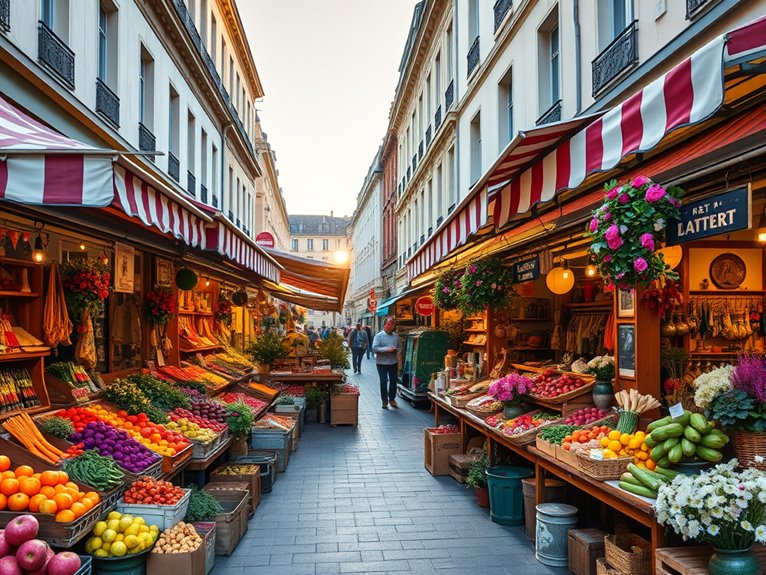
Paris's open-air markets are vibrant threads in the city's cultural fabric, offering visitors a genuine slice of Parisian life without spending a euro. These bustling marketplaces, known locally as "marchés," showcase everything from fresh produce and artisanal cheeses to vintage trinkets and local crafts, creating a sensory experience that captures the essence of French daily life.
While tourist attractions like the Louvre and Eiffel Tower draw crowds, Paris's markets provide an authentic cultural immersion where locals shop, socialize, and maintain centuries-old traditions. Wandering through these markets offers budget travelers the opportunity to photograph colorful displays, sample free tastings, and observe the animated interactions between vendors and customers that make Paris's market culture so distinctive.
Quick Facts:
- Best visiting hours: 8:00 AM – 1:00 PM (markets typically close by 2:00 PM)
- Peak days: Weekends are busiest, weekdays are more relaxed
- Photography: Permitted, but ask vendors before taking close-up shots
- Free samples: Often available at cheese, bread, and fruit stands
- Weather consideration: Most markets operate year-round, rain or shine
- Language: Basic French phrases appreciated but not required
Notable Markets:
Marché d'Aligre (12th arrondissement)
One of Paris's most authentic markets, combining a covered market hall with outdoor stalls. Operating Tuesday through Sunday, 8:00 AM – 1:00 PM, this market offers an eclectic mix of fresh produce, antiques, and international foods. Insider tip: Visit around noon when vendors begin discounting their produce.
Marché aux Fleurs (4th arrondissement)
The city's oldest flower market, dating to 1808, transforms into a bird market on Sundays. Located on Île de la Cité, it operates Monday through Saturday, 8:00 AM – 7:30 PM. Insider tip: The market is particularly photogenic in early morning light when vendors are arranging their displays.
Marché Bastille (11th arrondissement)
One of the largest open-air markets in Paris, operating Thursday and Sunday mornings. Features over 100 vendors selling everything from fresh seafood to artisanal honey. Insider tip: Enter from the Rue du Faubourg Saint-Antoine end to avoid the largest crowds.
Pro Tips:
The most rewarding market experiences happen early morning when produce is freshest and vendors are most energetic. Bring a camera, small change for any purchases, and reusable bags if planning to shop. Consider visiting multiple markets across different neighborhoods to experience the unique character each brings to its quarter. Some vendors offer end-of-day discounts, but morning visits guarantee the best selection and photo opportunities.
Practical Advice:
Respect the local market culture by not touching produce without permission and using basic French greetings like "Bonjour" and "Merci." Many vendors appreciate customers who show interest in their products, even without making purchases. Avoid blocking walkways while taking photos, and be mindful that these are working markets serving local residents, not tourist attractions. Keep valuables secure as markets can get crowded, and bring cash if you decide to make purchases, as not all vendors accept cards.
